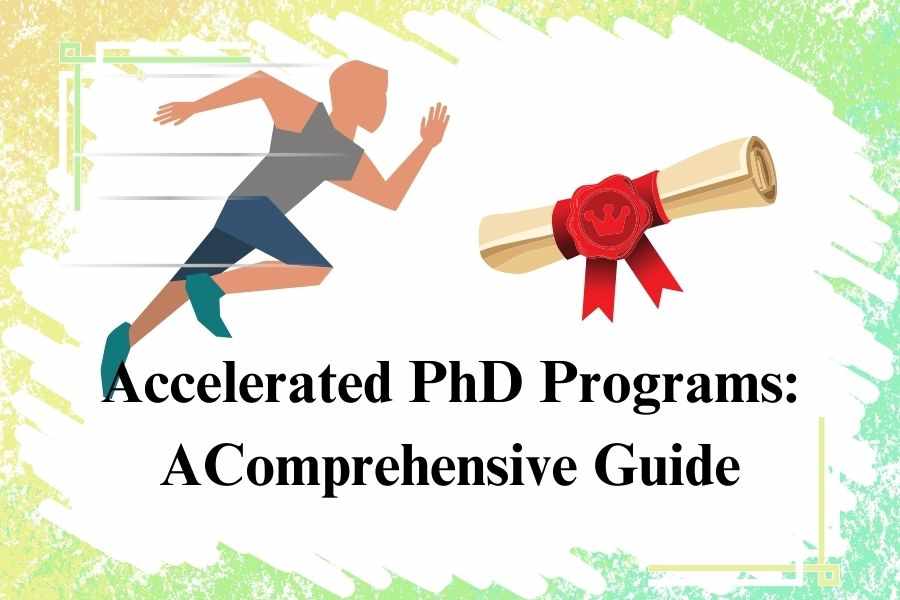Last updated on November 25th, 2025 at 01:23 pm
Are you considering a research career? Here’s your ultimate guide on how to choose a PhD program that perfectly aligns with your academic aspirations and sets you on the path to and make a lasting contribution to your discipline.
Table of Contents
Step 1: Understanding a PhD Program
During the initial two years of your PhD, you will have the opportunity to delve into several areas of interest by engaging in coursework.
Throughout the subsequent years, you will have the opportunity to choose and engage in an independent research project that will yield a novel and valuable addition to the current corpus of knowledge within your respective academic discipline and will culminate your original study with a comprehensive written document referred to as the PhD dissertation.
Step 2: How to Ensure Getting A PhD Is A Pefect Fit
Before diving headfirst, take a moment for introspection. A PhD demands dedication, resilience, and a genuine love for research. Here are some questions to ponder:
You’ll need to systematically scrutinize and follow these instructions as much as possible (they’re in a specific order for a purpose). Some of them require you to take action, while others encourage you to step out of your comfort zone and investigate a great deal. The internet can be a good friend!
- Take your time and think hard: Carefully evaluate the selection of a PhD program since it now encompasses more than just achieving a degree.
- Maintain a Checklist: Make precise notes of the various parameters listed below and seriously consider each one of them before embarking on a PhD program. Remember, it can take several years, surely you can invest a few months to investigate and reconfirm that you are on the right track.
Step 3: Are You Ready for the PhD Quest?
Answer these questions honestly to prevent any disillusionment later on in the PhD program, and might shed light on your professional aspirations and help you decide whether or not pursuing a doctorate is the best course of action:
- Do I have the personality traits that might make me successful in a university setting?
- Do I have the drive to research and find the answers on my own?
- Do I want to spend the rest of my life reading about and discussing research?
- Can I apply to this PhD. program with confidence that I have a solid enough academic background to get accepted?
- Is this the right time to get a doctorate?
- After I finish my PhD, what next?
If your answers justify engaging with a PhD program, it’s time to choose a PhD program:
Step 4: How to Choose a PhD Program: Finding Your Dream Mentor
Your PhD supervisor will be your academic mentor, guiding you through the research process. So, finding someone whose expertise aligns with your interests is crucial. Here’s how to approach this:
- Deep dive into your field: Explore current research trends by reading academic journals, attending conferences, and engaging with online communities in your field.
- Faculty Focus: Research potential supervisors at your shortlisted universities. Look for professors whose research aligns with yours and who have a strong publication record. Utilize university faculty directories and research group websites to identify potential matches.
- Reach Out & Connect: Don’t be shy! Contact potential supervisors via email to express your interest and inquire about their current research projects. Briefly introduce yourself, highlight your research interests, and ask if they’d be open to discussing potential PhD opportunities.
Freshers’ Tip: When contacting potential supervisors, personalize your email. Briefly mention a recent publication of theirs that caught your attention and how your research interests align with their work.
Pro Tip: Consider attending virtual information sessions or webinars hosted by PhD programs of interest. These sessions often feature faculty members discussing their research and answering questions from prospective students.
Step 5: Beyond the Lab – Program Strength and Resources
A strong PhD program offers more than just renowned faculty. Here are some key aspects to consider:
- Curriculum: Does the program offer coursework that complements your research interests and equips you with essential research skills (e.g., data analysis, research methods, scientific writing)? Explore course descriptions and syllabi to get a sense of the curriculum’s focus.
- Funding Opportunities: Explore scholarships, research assistantships, and fellowships within the program and through external organizations. Don’t hesitate to contact the program’s financial aid office for guidance.
- Research Facilities: Does the university have the necessary labs, equipment, and resources to support your research project effectively? Consider factors like access to specific software, specialized equipment, or research libraries.
Freshers’ Tip: If funding is a concern, explore programs with guaranteed funding packages for incoming PhD students. Many universities offer research assistantships that provide a stipend in exchange for assisting with faculty research projects.
Don’t Forget! Investigate the university’s career services department. They can provide valuable guidance on preparing for academic or industry jobs after your PhD. Additionally, some programs offer career development workshops or professional development opportunities specifically for PhD students.
Step 6: Finding Your Tribe – Program Culture and Community
A supportive PhD program becomes your academic home for several years. Here’s why the program culture matters:
Work-Life Balance: Does the program acknowledge the importance of well-being and offer resources to support students in maintaining a healthy balance? Look for programs with workshops on time management, stress management, or mental health resources.
Diversity and Inclusion: Does the program value diversity in its faculty and student body, creating a welcoming and inclusive environment for all? Consider factors like student organizations, mentorship programs, or initiatives specifically aimed at supporting students from underrepresented backgrounds.
Freshers’ Tip: Reach out to current PhD students in your program of interest. They can provide invaluable insights into the program culture, faculty dynamics, and overall student experience. Many universities have student associations or online forums where you can connect with current students.
Step 7: The Big Picture – Location, Logistics, and Intuition
While academics are paramount, consider these practical factors as well:
Location: Does the program’s location suit your lifestyle preferences and cost-of-living considerations? Think about factors like access to public transportation, proximity to family or support networks, and the overall culture of the city.
Logistics: Think about housing options, proximity to research facilities, and the availability of childcare or other support services you may need.
Intuition Matters: Ultimately, trust your gut feeling. Does the program resonate with you? Do you envision yourself thriving in its environment? Consider visiting the university (if possible) or attending virtual campus tours to get a feel for the atmosphere.
Freshers’ Tip: Don’t be afraid to negotiate! Some universities may be willing to offer financial aid packages or signing bonuses to attract top PhD candidates.
Step 8: The Application Process – Building a Strong Case
Once you’ve identified your top program choices, it’s time to craft a compelling application. Here are some key elements:
Strong Statement of Purpose: This is your chance to shine! Clearly articulate your research interests, relevant skills, and experiences, and why you’re a perfect fit for the program. Highlight your alignment with specific faculty members and research projects.
Stellar Letters of Recommendation: Request letters from professors who can speak to your academic abilities, research potential, and work ethic. Provide them with relevant information about your research interests and career goals to help them write strong letters.
Standardized Tests (if required): Some programs require standardized tests like the GRE or subject-specific exams. Research the program’s requirements and ensure you take the necessary tests well in advance of the application deadline.
Academic Transcripts: Request official transcripts from all universities you previously attended.
Freshers’ Tip: Start working on your application materials early! Give yourself ample time to gather all required documents, solicit letters of recommendation, and revise your statement of purpose.
Pro Tip: Most universities will fund your PhD prpgram ( generally between $ 300,000 to half a millioni) provided you satisfy them why they should invest in you. Your SOP must convince them about your research goals aspirations and how you will add new/unique/valuable studies in the discipline. Your letters of recommondations will be almost as important and must highlight your research abilities and interest.
Polish Your Armor (Optional): Consider taking a GRE prep course or attending workshops on writing a strong statement of purpose. A little extra preparation can go a long way in making your application shine!
Freshers’ Tip: Don’t underestimate the power of online resources. There are many websites and forums dedicated to helping students craft compelling PhD applications.
Step 9: Making the Decision – Weighing Your Options
Congratulations! You’ve received offers from several PhD programs. Here’s how to choose the best fit:
Revisit Your Priorities: Reflect on your initial goals and priorities when you began your search. Which program best aligns with your research aspirations, funding needs, and desired program environment?
Talk to Your Network: Discuss your options with faculty mentors, advisors, or current PhD students. Their insights can be invaluable in helping you make an informed decision.
Visit the Campus (if possible): If resources allow, schedule campus visits to experience the program culture firsthand. Meet with faculty and current students to get a deeper understanding of the program.
Think About Your Future: Consider the program’s alumni network and career placement resources. Imagine the connections and career opportunities a strong PhD program can offer!
Freshers’ Tip: Don’t feel pressured to accept the first offer you receive. Take your time, weigh your options carefully, and choose the program that best positions you for success in your PhD journey.
Pro Tiip: The QS World University Rankings is a reputed organization known for its comprehensive assessment of universities worldwide, and it will benefit to look up the status of the university under consideration.
Step 10: Prospects for Teaching and Mentoring
If you have a penchant for teaching or mentoring should take into account the program’s offerings in terms of acquiring pedagogical experience or assuming the role of a teaching assistant.
The acquisition of teaching experience holds significant value for anyone aspiring to pursue an academic profession in the future, as it offers a platform to cultivate essential communication and leadership abilities.
Step 11: . International Opportunities and Mobility
It is important to assess if the program provides avenues for partnerships or research exchanges with institutions of worldwide repute if you have a keen interest in gaining foreign experiences.
Ensure that you evaluate various efforts, such as establishing foreign research alliances, participating in study abroad programs, or securing financing to attend conferences or workshops worldwide.
Step 12: Examine the Historical Performance
Understand the duration for degree completion within the program, as well as the overall rates of successful completion.
Gaining insights on punctual completion can facilitate strategic planning of your academic trajectory and provide an assessment of the program’s efficacy in providing you with enough support throughout the progression.
Step 13: Alumni Happiness and Engagement
Initiate communication with program alumni to acquire valuable perspectives on their program experiences and levels of contentment.
Request information on the professional paths pursued by others, the assistance they obtained during their educational pursuits, and the prospects they were offered after completing their Ph.D. program.
The presence of actively involved and helpful alumni inside the program can serve as a significant indicator of a robust sense of community and continuous assistance.
Step 14: Recommended: Do’s and Dont’s
Finally, to avoid choosing a wrong PhD program, here’s recommended do’s and don’ts checklist to prevent making a wrong decision. Rememmber, there is a lot at stake!
DO’S | DON’T’S |
Think carefully about your options, and then make a call. | Accept the first available research opportunity and you may find yourself learning about Medieval politics instead of biochemical polymers. |
Find out what kinds of doctorates are available in your field of study and what sets them apart from one another. | Spend long hours wondering why the field of seventeenth-century mathematics lacks an undergraduate degree of Administration in Business |
Look for a project that has goals you’re interested in, that addresses problems you care about, and that asks questions you want answered. | Waste time evaluating the concepts of theoretical mechanics, when you’re more drawn to the field of Electronics, |
Learn about the existing research in your area and consider how it relates to your project. | You might believe your PhD thesis topic is novel, only to find out that several other individuals are studying the same thing. Four of them are preparing to publish their findings to the public. |
Look at some contemporary work in your area of expertise and ask yourself, honestly, if this is the type of content you can picture yourself reading (and maybe authoring) over the next three years or so. | Spend three years in graduate school only to find that reading research papers is the most painful part of the entire experience. |
Learn to appreciate the role your regular habits have in ensuring your satisfaction and success. Imagine what it would be like to spend your days working on this project and your nights in this facility. | Do not let superficial factors, such as a better Starbucks or a brand new bookstore (with none of the journals you need) sway your decision of where to do your PhD. |
Consider the qualities you’ll want in a PhD. advisor and the personalities that may deliver them. | To get feedback on your research project, you should add every possible supervisor you can locate on Linkedin and send them a message. |
Think about why you want to do a PhD, what you intend to accomplish, and what other paths may be open to you in case your initial objectives change. | Think that getting a PhD will guarantee you a certain position (in the scientific community or otherwise), or fail to take advantage of the time to improve your abilities and carry on what a PhD provides. |
FAQ’s
Which PhD is most respected?
STEM (science, technology, engineering, and mathematics) disciplines, which include physics, chemistry, mathematics, computer science, and engineering, typically provide the most prestigious PhD degrees in the academic community. Moreover, PhDs in psychology, medicine, and economics are all highly esteemed.
How do I choose a PhD specialization?
Consider your passions, aspirations, and professional objectives while choosing a specialism. Consider the research subjects you might choose to write about for your dissertation. You can use the knowledge you acquire in your specialized classes to help you finish your study.
Conclusion
Earning a PhD is a rewarding yet challenging endeavor. By taking the time to choose the right program, you’ll set yourself up for success and pave the way for a fulfilling academic journey. Embrace the exploration process, trust your instincts, and get ready to embark on an incredible adventure in the world of research!




